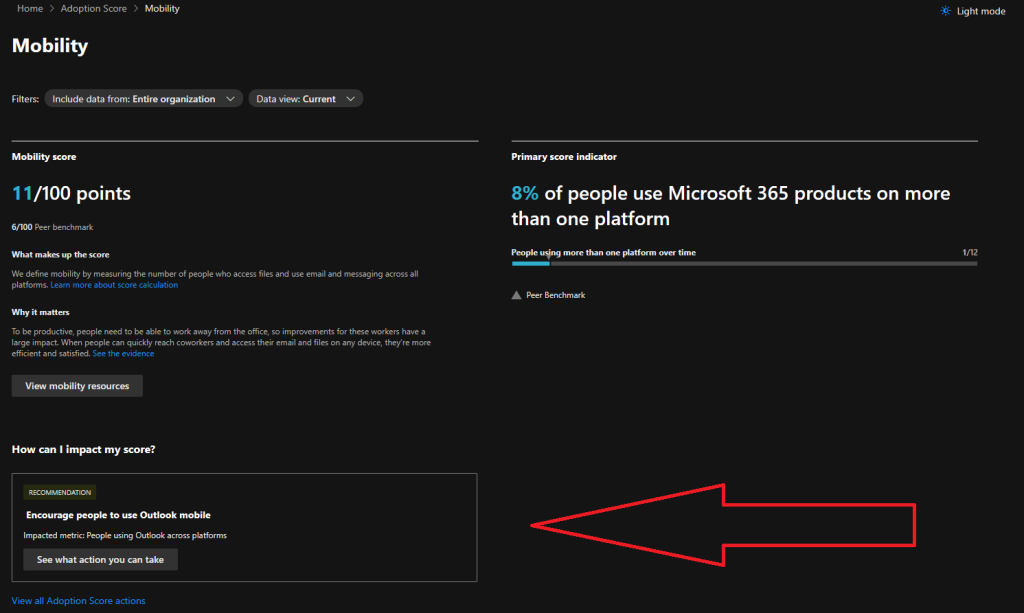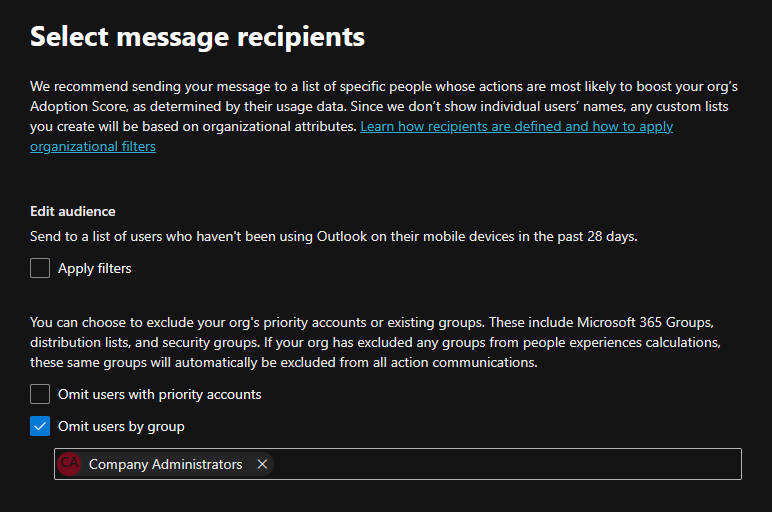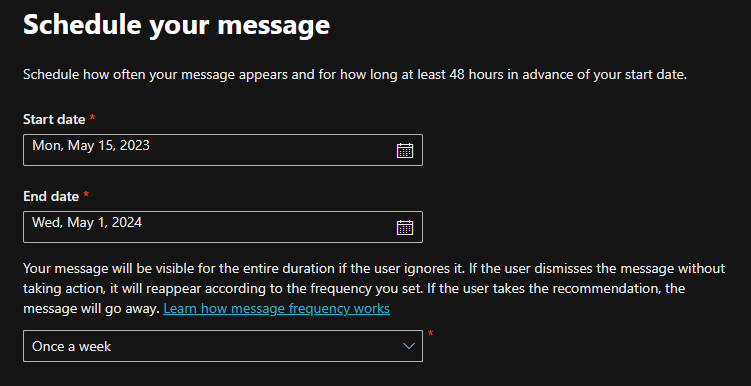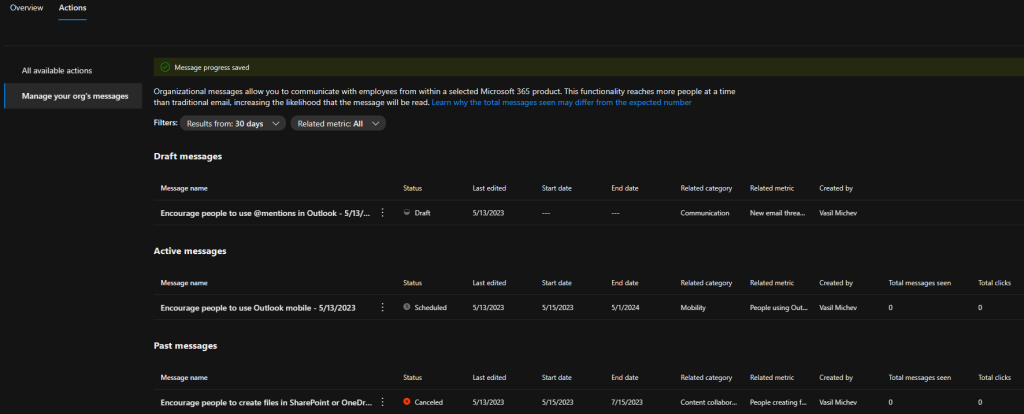Adoption score, also known as Productivity score, faced some (undeserved) bad publicity when it initially launched back in 2020. In response to all the criticism, Microsoft decided to go away with the user-level insights, which in turn took away one of the key functionalities of the tool – the ability to distribute targeted communication or take other actions against users that fall behind the average “scores” within the organization. Few years and a rebrand later (“adoption” does sound better than “productivity” when put in the context of a single user’s work habits), Microsoft is rolling out a new feature to allow organizations to push targeted messages in order to encourage the use of new products, or specific features within a product, all while respecting user’s privacy.
Meet “organizational messages”. In short, Organizational messages are targeted, in-product popups that can be used to nudge users to try a given product or a feature. They are part of the broader “actions” capability of Adoption score, which should eventually be expanded to more than simple popup messages. For now, as part of the public preview of Organizational messages, we can choose from five different “messages” to use, as follows:
- Encourage people to create files in SharePoint or OneDrive.
- Encourage users to email files with cloud attachments.
- Encourage people to communicate using Teams.
- Encourage people to use @mentions in Outlook.
- Encourage people to use Outlook mobile.
To configure Organizational messages, a Global admin, or a user holding the newly introduced Organizational message writer role, must login to the Office 365 Admin Center and navigate to Reports > Adoption score > Actions. Click on one of the available items therein and then hit the Create message button in the Recommended action details pane in order to launch the Organizational messages wizard. An alternative entry point to the same wizard is via the newly introduced Recommendations within each Adoption score category, illustrated below:
The Organizational messages wizard interface itself is quite easy to use and includes lot of contextual information. After skipping the Overview page, you can select the Messages you want to configure, which usually come in form of three built-in templates per category. All three templates differ only on the wording, whereas the rest of the UI elements are the same, and not configurable. For example, the “Encourage people to use Outlook mobile” category I’ve selected here allows you to select between the following:
- Using Outlook on mobile devices helps you stay connected and available.
- Stay up to date by accessing Outlook email on your mobile devices.
- Stay accessible and connected by using Outlook on your mobile devices.
As mentioned above, no other element of the message can be customized. Not the color, not the position, not the “A message from your admin” prefix, nor any button(s). As those messages are displayed within the Office apps themselves, Microsoft is taking a very cautious approach here. They’re also providing you with the opportunity to preview the message as well as informing you where exactly within the host application’s UI will it appear. Overall, a nice touch, albeit very cautious one, which will likely raise requests to provide additional customizability.
Once you’re satisfied with the message, continue to the Recipients page where you can narrow down the scope of the action, i.e. trim the list of users that will be targeted. Again, Microsoft is taking a very cautious approach here and will not reveal the list of users. Instead, they’re telling you the criteria based on which users will be included, which in the scenario selected above this is the set of users who haven’t been using Outlook on their mobile devices in the past 28 days. As Adoption score insights are refreshed daily, the list will be fluid.
In addition, you are given several options to narrow down the list. You can use the Apply filters control to include users by group membership, Location, Department or Company, with the latter three available only if you have configured Group level aggregates. In addition, you can exclude any VIP users by toggling the Omit users with priority accounts control, or exclude them based on group membership via the Omit users by group control.
Lastly, you can configure the Schedule of the organizational message. Specify a Start date, End date (max an year out) and interval to be used (select between 1-4 weeks cadence). On the final page, review the settings and if you are satisfied with them, hit the Schedule button to enable the Organizational message. Yet another “safety” is triggered at that point, as Microsoft will ask you to acknowledge the following:
I confirm that this message complies with my company’s privacy policies, and allow Microsoft to send it to the specified users. I also confirm that this functionality is in preview.
Once an Organizational message has been scheduled, you can manage it under the Adoption score > Actions > Manage your org’s messages page. The actions you can perform here include edit the organizational message object, complete a saved/unfinished draft message or delete it, clone a message object, or cancel any active message’s schedule. It would’ve been nice if the details presented on the page included some additional statistics, but I guess Microsoft is again being overly cautious here too and trying to avoid any potential privacy issues.
That’s pretty much all there is to the feature in its current state. For some additional details as well as screenshots of the in-product message popups, you can refer to the official documentation. A similar-named feature is in preview for Intune as well, allowing you to display a message within the Taskbar, Notifications are or the Get started app on Windows 10/11 devices managed by Intune. The biggest differences between the two features is the way users are being targeted, with the Intune feature not bothering with any privacy-related concerns it seems 🙂
P.S. Interestingly enough, I couldn’t find any Audit records generated by the feature, but that might be due to the usual delays with the data ingestion process. I’ll circle back to update the article later on, just in case.



